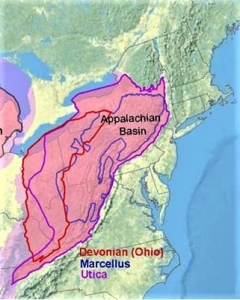Noah’s flood and the Appalachian basin
On the Rocks; The Woodstock Times 2020
Updated by Robert and Johanna Titus
This week, once again, we continue our quarrel with young earth creationists. They comprise, as is commonly known, a sizable branch of fundamentalist protestants who have opposed the basic tenets of geological theory ever since they were first worked out during the early 19th century. Briefly, creationists look into the Old Testament of the Bible for their geological histories; rocks are far less, if at all, important. They argue that the geological bedrock record is largely the product of one event, the deposition of sediments from the waters of Noah’s worldwide flood. That occurred, they claim, in the year 2,348 BC, just a little after the great pyramids are known to have been built. Curiously, the ancient Egyptians seem to have taken little notice.
Geologists, starting in the 1790’s, saw earth history differently; they recognized that many of the world’s sedimentary rocks began as sediments that had been eroded and then washed off of the slopes of rising mountains. As those mountains weathered away, thick sequences of sedimentary rock accumulated within nearby marine basins. They went on, immediately, to realize that these sorts of processes must have required enormous, truly vast lengths of time. It was a great moment in this history of geology and, indeed, of science itself. The great antiquity of the Earth was being recognized for the first time. There was, back then, relatively little religious opposition to any of this. That opposition would not appear until after 1859 when Charles Darwin came along and dressed up these eons of time with a history of evolving, life.

One of these sedimentary basins is called the Appalachian basin. We illustrate it in our map, courtesy of Wikimedia Commons. It originally accumulated sediments that were literally miles thick. These, with time, hardened into sedimentary rocks just as thick. All the rocks you will see throughout Woodstock and all of the Catskills are but a tiny fragment of this unit. Notice that our part of the basin lies immediately west of the Northern Appalachian Mountains. To the south, the basin lies just west of the Southern Appalachians. Yep, there is a relationship. Let’s follow the evidence and see where it leads us.
The basin’s sediments thin westward, away from the Appalachians. The suggestion is that, indeed, as the Northern Appalachians were rising, they were also eroding away. Those sediments weathered off of those mountains and, logically, were thickest where they were closest to their source. They thinned away from that source, all the way to the deep interior of our continent. None of this matches the account of Noah’s flood hypothesis. Flood deposits should not be concentrated adjacent to old mountain ranges; instead, they should be spread out more or less evenly all over the world.
New York State geologists started putting together this history during the 1840’s. By the early 20th century most of the major elements of the story had been outlined. In the 1960’s plate tectonics came along and provided crucial insights into a deeper understanding of these processes. Since then more and more details have been, and are being ironed out.
This view of our region’s geological history requires all of the enormous lengths of time that we spoke of earlier. Geologists know this from the study of modern mountain ranges. How long does it take for a mountain range to rise? We geologists think it takes tens of millions of years. How long does it take weathering and erosion to “melt” those mountains away? Again, tens of millions of years.
There are real patterns in these strata. None of them match the expectations of the flood hypothesis. All of them match the predictions of the scientific theory of mountain building. This is, indeed, proper science.
Contact the authors a randjtitus@prodigy.net. Join their facebook page “The Catskill Geologist.” Read their blogs at “thecatskillgeologist.com.”





